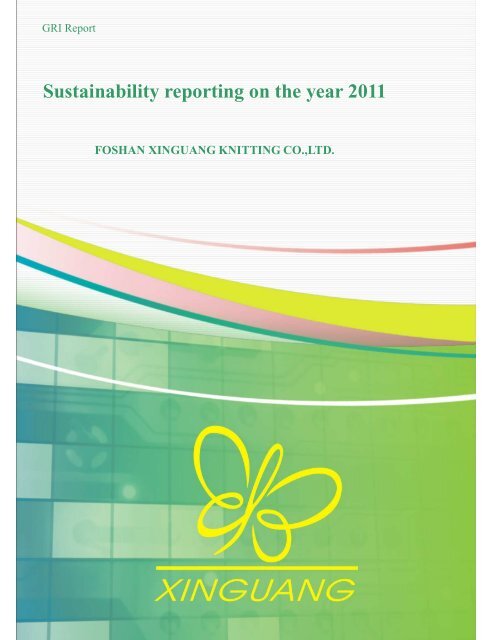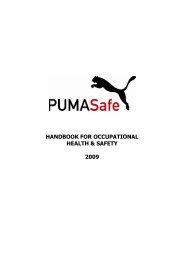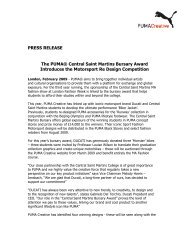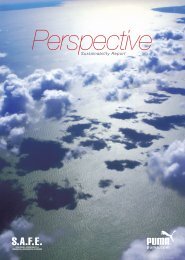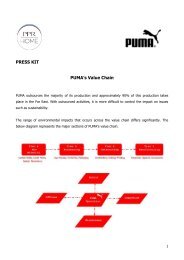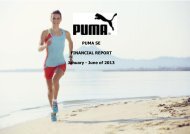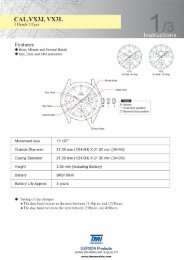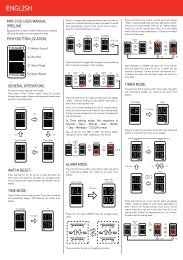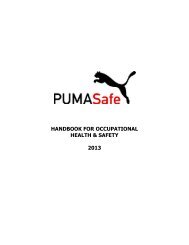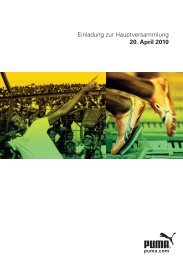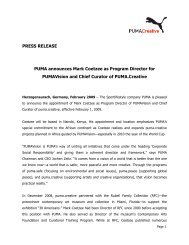Foshan Xinguang Knitting Co. Ltd - About PUMA
Foshan Xinguang Knitting Co. Ltd - About PUMA
Foshan Xinguang Knitting Co. Ltd - About PUMA
- No tags were found...
You also want an ePaper? Increase the reach of your titles
YUMPU automatically turns print PDFs into web optimized ePapers that Google loves.
GRI Report¥ ¥Sustainability reporting on the year 2011FOSHAN XINGUANG KNITTING CO.,LTD.
Sustainability reporting on the year 2011<strong>About</strong> this Report<strong>About</strong> this ReportReporting periodThis report primarily focuses on thinking, efforts and accomplishments of <strong>Xinguang</strong> <strong>Knitting</strong> <strong>Co</strong>,<strong>Ltd</strong>. for fiscalyear 2011, the period from January 1, 2011 to December 31, 2011, with the data reflecting the actual results forthat period.The report also includes the thinking, approaches and data prior to January 1, 2011.Reporting cycleThis report is Xingguang <strong>Knitting</strong> <strong>Co</strong>.,<strong>Ltd</strong>’s second GRI report. The report is published annually.Reporting boundaryIn principle, this report covers the wholly owned operations of <strong>Xinguang</strong> <strong>Knitting</strong> <strong>Co</strong>.,<strong>Ltd</strong>, while theenvironmental sections cover the printing and dyeing supplier that has formed water recycle system in conjunctionwith Xingguang <strong>Knitting</strong> <strong>Co</strong>.,<strong>Ltd</strong>.Please note that this report generally uses the term “<strong>Xinguang</strong>” to indicate the <strong>Xinguang</strong> <strong>Knitting</strong> <strong>Co</strong>, <strong>Ltd</strong>. Oursustainability report publishes once a year.Process for defining report contentAdhering to importance, integrity and comparability about GRI and principle of stakeholder participation, thedevelopment of criteria for materiality and selection of priorities for reporting have been based on <strong>Xinguang</strong>’sexperience of many years with respect to sustainability topics, complemented by analyses of corporatedevelopment strategies, differentiation of key topics and comprehensive dialogues with stakeholders.Written standardIn the present GRI report of 2011, through the voluntary application of G3.1 Guidelines which was written by GRI(Global Reporting Initiative), we believe our information disclosure reaches B level.Data Source and MeasurementAll data concerning KPIs source from <strong>Xinguang</strong>’s official files and statistical reports. During the period ofselecting indicators which are published in this report, <strong>Xinguang</strong> mainly thinks over the relevance, materiality andavailability of different concrete indicators.II
Sustainability reporting on the year 2011<strong>Co</strong>ntent<strong>Co</strong>ntent<strong>Co</strong>ver Page<strong>About</strong> this Report ............................................ IIMessage from the chairman ........................... 1Organizational Profile ..................................... 2<strong>Co</strong>rporation Introduction ........................... 2Organizational Structure ............................ 2Awards ......................................................... 2Social Responsibility Sense ...................... 2<strong>Co</strong>rporation Governance ................................ 5Member of governance body ..................... 5<strong>Co</strong>mpensation mechanism ........................ 5<strong>Co</strong>mmunication mechanism ...................... 5<strong>Co</strong>nflicts of interest avoiding mechanism............................................................................. 5Risk management ....................................... 5External charts endorsed .......................... 6Membership in association ....................... 6Engagement with stakeholders ................. 6Economic ......................................................... 7Product safety management ..................... 8Production process reconstruction .......... 8Quality control ............................................ 9Capability of self-testing ............................ 9Environment ..................................................10To perfect regulatory system,strengthen routine monitoring ................ 10Actively to build green supply chain...... 10Water ......................................................... 10Energy consumption ............................... 12GHG Emissions, effluent and waste ....... 13Labor .............................................................. 16Principle of non-discrimination .............. 16Focusing on job training ......................... 17<strong>Co</strong>mmunication from the heart ............... 18Human Rights ................................................ 19Democratic managment .......................... 19Reinforcing propaganda of humanrights ................................................................. 19Prevention of child labor, forced andcompulsory labor ..................................... 20Society ........................................................... 21Integrity management and faircompetition ...................................................... 21Anti-corruption ......................................... 21<strong>Co</strong>mmunity ................................................ 21Outlook 2012 ................................................. 23GRI <strong>Co</strong>ntent Index ........................................ 24B level: Self declaration ............................... 30Feedbacks ..................................................... 31III
Sustainability reporting on the year 2011Organizational ProfileOrganizational Profile<strong>Co</strong>rporation IntroductionFounded in 1954, <strong>Foshan</strong> <strong>Xinguang</strong> <strong>Knitting</strong> <strong>Co</strong>. <strong>Ltd</strong> is a historic factory, reconstructing from stated-owned<strong>Foshan</strong> Pioneer <strong>Knitting</strong> Manufacturer to Sino-foreign joint ventures limited liability company in 1999. Due tourban rectification and environment protection, the company has realized an integral moving from ChanchengDistrict to Xiqiao Science and Technology Industrial Park, Nanhai District, where is famous for fabrics.<strong>Co</strong>mpany’s existing plant area is 30,000m2, and its main products include series of children and adults’ fashionmade from knitting fabrics of different structures. The company processes and manufactures apparel productionsfor international famous brands, such as Puma, Reebok, Dunlop, Redwood, Stussy, Obey, Cygele, Unedfeated,Gotzburg and so on.Organizational StructureChainmanGeneralManagerVice GeneralGarment OperateUnionPurchaseFacilityFinanceManagerDepartmentPresidentDepartmentDepartmentDepartmentAdministrativeWarehouseGarmentA.Q.L.InteriorHROfficeFactoryTeamDepartmentdepartmentAwardsIn Nov.2010, awarded Chinese Science and Technology <strong>Co</strong>ntribution Award in <strong>Knitting</strong> IndustryIn May 2011, awarded Creditable <strong>Co</strong>rporate in Guangdong ProvinceSocial Responsibility SenseEnterprise vision<strong>Foshan</strong> <strong>Xinguang</strong>, to become prior in knitting profession, and to be one of National Top 500 knitting enterprises;To respect and value staff and to assure employee’s individual growing up and developing with <strong>Xinguang</strong>;To maximize profits for shareholders and to pay back society positively.2
Sustainability reporting on the year 2011<strong>Co</strong>re valuesBuild a world-famous brand with best quality.Make perfection more perfect with best service.Boost enterprise benefits with fine workmanship.Produce Eco-textiles to fulfill social responsibility.Organizational ProfileCSR strategy<strong>Xinguang</strong> has established a social responsibility management system, covering responsibilities of economy, safetyproduction, products quality, environment, human rights and society aspects. We promise and execute strictlymoral norms, laws and regulations. We also care about and respond to expectations of relevant interest parties toundertake the responsibilities for economy, environment and society. Through these efforts, we will realize awin-win among government, staff, society and environment and hold sustainable development.Figure 1 Frame of CSR Responsibility3
Sustainability reporting on the year 2011Organizational ProfileCSR action planIn recent years, we vigorously carried out enterprise’s social responsibilities. During the process, we graduallyrealized that although we had certain achievement, as we can see the GRI Report of <strong>Xinguang</strong> in 2010/2011, theawareness of social responsibilities of staff and even the whole supply chain should be improved. Therefore, weneed to improve from the following aspects:Firstly, we should promote the staff’s awareness of social responsibilities and create a cultural atmosphere braveenough to undertake social responsibilities. We will embark from enterprise management and make the staffrealize the importance of taking social responsibilities from top to down. We will radicate an example enterpriseand organize management to learn the concept and method of it.Secondly, we should deepen the alteration cooperation of energy conservation and emission reduction withsuppliers. Since the year before last year, water consumption of toilets in workshop was replaced with rinse waterprovided by printing and dyeing supplier, which achieved a win-win. We will promote cooperation andcommunicate practical experience of energy conservation and emission reduction. We will make efforts together tocreate green production environment and achieve the goal of ecological knitting.4
Sustainability reporting on the year 2011<strong>Co</strong>rporation Governance<strong>Co</strong>rporation GovernanceMember of governance bodyTable 1 Member of managementManagementResponsibilityChairmanBe responsible for enterprise’s financial affairs.LU MingkengGeneral ManagerLi LichangVice General ManagerHuang WeimingVice Party SecretaryChen Zhengnanchairman of Labor UnionHuang JianchangBe responsible for enterprise’s overall operation and actualize annual business plan andinvestment projects, emphasizing on promote enterprise’s economic profits.Be responsible for enterprise’s administration operation, function division and appointing andremoving of middle management; representative of quality management system; and beresponsible for human right affairs.Give a training for new employees about enterprise’s basic situation and security education;check all sanitation, security, and fireproofing regularly and assure working environmentmeets products’ fabricating requirement.<strong>Co</strong>mpensation mechanismTo make personal goal of high management comply with the middle and long-term strategy of realizing enterpriseachievements, signing a prosecution contract and share plan is essential to confirm high management’s salary. Onthe basis of signing prosecution contract and setting annual goal, we decide salary of each director andmanagement.<strong>Co</strong>mmunication mechanismTo enhance staff’s participation of enterprise management, we set up communication mode at each administrativelevel. There are mainly vertical communication, including congress of workers and staff, internal website, email,monthly staff suggestion consult and advice mail box in workshop, and so on. Therefore, management can have aperspicuity of staff’s interest requirement, indicating our valuing and respecting staff’s rights and interest.<strong>Co</strong>nflicts of interest avoiding mechanism<strong>Co</strong>ntrolling beforehand is an important system of settling conflict of interest among directors. We employ highmanagement strictly and they must sign <strong>Foshan</strong> <strong>Xinguang</strong> appointment contract, which clearly regulates postqualifications, function purview and payment and welfare. As with important operational decision-making, weconvene a directorate meeting and adopt an open vote system to make the decision.Risk managementWe set up risk management system, and strengthen risk warning and prevention and value cultural construction ofrisk management. We also help staff to set up a concept of “whenever and wherever here is risk”, and cultivatefavorable ability of managing risks. Through overall risk identification, our risks are mainly market risk andproduction safety risk. In allusion to the former, we hold a production meeting among middle and highmanagement weekly and order quantity estimating meeting monthly, and discuss future market demand and pricechange and corresponding action we should take. As with production safety risk, morning meeting in workshopscan awake staff to pay attention to production safety all the time and we hold fire drill yearly to strengthen staff’s5
Sustainability reporting on the year 2011warning awareness of safety production.<strong>Co</strong>rporation GovernanceExternal charts endorsedBy far, we haven’t yet attended or supported convention, tenet, or other proposition about economy, environment,and society launched by external individual or organization.Membership in associationChina Textile Enterprises LeagueChina <strong>Knitting</strong> AssociationGuangdong Province Textile Profession League<strong>Foshan</strong> Textile Fashion Trade AssociationXiqiao Textile AssociationXiqiao Chamber of <strong>Co</strong>mmerceEngagement with stakeholdersThe stakeholders are in accordance with the first GRI report issued by our enterprise. But this report we addexpectations and requirements of relevant interest parties when exposing relevant interest parties. It is summarizedthrough communication forms such as emails, phones, enquiries, daily communication, and speaking face to face.Table 2 Engagement with stakeholdersStakeholders Basis for identification and selection Key topics Approaches to stakeholder engagementShareholders Being the owner of enterprise To maximize the profitMonthly office meeting/annual shareholderconventionCustomersBeing the source of enterprise valueTo supply super qualityproducts with best priceEmail/interview/telephone conferenceStaffsBeing the bedrock of value creationTo ensure stable employmentand rights protectionBy signing labor contract/advice mailbox/monthly staff suggestion consultSuppliersBeing the strategic partnerTo maintain long termcooperationEmail/interviewGovernmentBeing the law maker and defender oflasting peace & stabilityTo comply with the laws, topay taxInterview/policy execution and acceptation ofsupervision<strong>Co</strong>mmunityBeing the provider of public serviceTo support the communitydevelopmentInterview/ participant in management6
EconomicSustainability reporting on the year 2011To do what is best for shareholder sEconomic1200100080060040020009 0 01 1 0 02010 20117.006.005.004.003.002.001.000.00-1.006.40 6.50 6.20 6.104.60 4.90 4.90 5.40 5.30 5.50 5.50Year¥ on¥ year%4.20 4.10Month¥ on¥ month%Basic¥ wage¥ level¥ in¥ <strong>Foshan</strong> China¥ CPI¥ in¥ 2011Dec¥ of¥ 20100 . 5Jan¥ of¥ 2011FebMarAprMayJunJulAugSepOctNovDec1 1 . 2- 0 . 2 0 . 1 0 . 1 0 . 3 0 . 5 0 . 3 0 . 50 . 1 - 0 . 2 0 . 3<strong>Xinguang</strong> all along maintains competitive advantages by best quality with best price, although the ever increasingcompetitive pressure of cost from Southeast <strong>Co</strong>untries. In 2011, the business volume with existing customersboosts and developed new ones. The turnover in 2011 keeps an upward tendency. However, the profit has beensqueezed by the growing increased operational cost. The profit dropped by 26.45%.In 2011, we contributed tax of RMB7.29 millions with down 11.14%. Even so, we are still one of top 20, whosepayment to government ranges from RMB 5 million to RMB 10 million./10,00014000120001000080006000400020000Turnover13013.628695.822010 2011Year/10,000)9000800070006000500040003000200010000Turnover by customer8431.185411.7920103560.2320112454.621586.9848.52 0 36.9 179.2 160.8Puma Obey Asobio Russell OthersCustomer/10,000120000100000800006000040000200000Operation <strong>Co</strong>st109236.372474.72010 2011Year/10,00010009008007006005004003002001000Payment of Workshop Employee WagesAnnual wage per capita3857.862.592.52700.491.71.510.502010 2011 YearWorkshop EmployeeWagesAnnualwage per capita/10,000820800780760740720700680Tax payment809.93728.762010 2011 Year/10,000454035302520151050Profit41.8930.812010 2011 Year7
Sustainability reporting on the year 2011EconomicProduct safety managementWe strictly comply with the Basic Safety Technology Prints, General Specification for Eco-Textiles and advocategreen production. Along with our textiles has passed the authorization of Oeko-tex 100, our productions hasbecome environmentally confidence textiles exempted from inspection.To make garment metal-free prior to delivery is our product safety management principle. We have purchasedmetal detectors NCA made in Japan to have every garment to passed through it, starting from all accessories andtrims to the bulk. For management, meanwhile, we developed “One Person, One Needle” Policy. All sewingworkers must be familiar with Needle Replacement Procedures before starting sewing; new needles are onlyhanded out when the damaged needle or all needle parts of a broken needle are returned to nominated person: If allparts of broken needles can not been found out, the sewing garment need to pass through the metal detector. Onlythe garment without broken needles can the employee get the new needle. All broken needles (all parts) must betaped on the broken needle report, which can guarantee the sewing garment without needles as well as manage theneedle stock control.Under above stringent product safety management, significant fines for non-compliance with laws and regulationsconcerning the provision and use of products and services never occur in <strong>Xinguang</strong>.Production process reconstructionAs we can see from below chart, we only assigned one nominated worker to examine cutting panels and printings.And only after sending panels to have printed in printing factory can the worker examined the printings.Intermittent working caused is common as well as losing panels easily. But through improving process, we dividethe panel checking and printing checking, that is for both are done by two nominated person. And the checkingwork must been done immediately once the cutting was finished. Now the production fluency has been greatlyadvanced, lowering the losing panels and stimulating workers’ production enthusiasm. Currently, the daily panelchecking quantities jump to around 4,000 pieces, up 50% than before.BeforeApprovepatternSpreadfabricCut fabricPanel check& PrintcheckAfterApprovepatternSpreadfabricCut fabric Panel check Print check* Pattern:the template of cutting fabric.Figure 2 Reconstruction of cutting procedure8
Sustainability reporting on the year 2011EconomicQuality control<strong>Xinguang</strong> gradually formulates the systematic quality controlprocess:Inline—Endline—ZDC—A.Q.L. and trains qualified QC personnel. Onevery control process we collect the daily/weekly/monthly/quarterly defectsstatistics, compared with the defective rates benchmark. The comparison analysiscan statistically support how to lower the defects rate at weekly quality controlmeeting. Now the production defective rate in <strong>Xinguang</strong> is down to 5%.Capability of self-testingTo save time and fee of regular fabric and garment testing, our inhouse-lab hasbeen accredited by SGS to do the normal testing items from 2010. The inhouse-labhas helped us to cut down the cost greatly. The average monthly testing fee hasdeclined to RMB 30,000-50,000 from RMB 100,000-200,000 and 1 working dayswe only take but 7-8 working days on SGS side. Nevertheless the testing items inour testing room have not been added since 2010. So we should equip the testingroom more and thus keep ongoing improving the capability of self testing.9
Sustainability reporting on the year 2011EnvironmentEnvironment<strong>Xinguang</strong> strictly implements domestic environmental law, such as Environment Protection Law of People’sRepublic of China and Energy-Saving Law of People’s Republic of China. At the end of 2010, <strong>Xinguang</strong> tried tointroduce environmental managing system ISO14001. Unfortunately, it didn’t pass the authentication. The mainreason was that our employees didn’t attach great importance to environment protection and their awareness ofenvironment protection was weak. But we didn’t give up and continued to perform the standard environmentalmanagement system and made it specified. In order to make the employees and top level of management familiarwith <strong>Xinguang</strong> environmental policy and advantages of environment protection on company’s economic interest,we held all kinds of environmental awareness trainings for all staff.To perfect regulatory system, strengthen routine monitoringOur enterprise has gradually formed a work team led by deputy general manager, coordinated by GM office,equipment department, logistic department and financial department, etc. to manage, fulfill, and superviseenvironment protection. Its work contains the designation of social responsibility management, implementation ofsocial responsibility practice (statistics), communication about social responsibility and compiling of socialresponsibility reports. Among them, daily supervision to collect, countand analyze energy consumption data arecritical. It is beneficial to promote energy conservation by collecting, analyzing and contrasting energy utilizationand consumption between offices and workshop.Equipment Dept.Water & Energy ManagementKPILogisticReportAdminist-ViceWaste, Capacity, fuel feeDept.Rative OfficeG.M.Financial Dept.Figure 3 Routine Monitoring SystemActively to build green supply chain<strong>Co</strong>nfronted with frequent “green bulwarks” built by western developed countries and continuously atrophiedconsumer confidence due to poisonous and harmful food, our enterprise clearly realized it’s quite necessary tobuild a green supply chain in the long term. The green supply chain requires that the design of the products’ wholelifecycle layout should be done from the perspective of environment protection and ecological consideration,including green design, green material, green production, green purchasing, packaging and transportation.Certainly the applying of concept of green supply chain also spread among our relevant interest parties includingsuppliers and clients. Therefore, our enterprise integrates the layout of products’ green lifecycle step by stepcombing with our own reality.WaterThe water consumption source is mainly from the water supplying system planned by industrial park committee,which does not make great impact on the surface water, ground water, lakes and rivers. During our productionprocess, it rarely involves water for industry. Instead, water for life is dominating supply for our office toilets andworkshop toilets. Our water-saving plans combine management and technological reformation of energyconservation and emission reduction, inclusive of water statistic, water reusing, publicity and education ofwater-saving, routine inspection of water-pipes.10
Sustainability reporting on the year 2011Environment Water used in office buildingThe toilets of office building have been installed squatting pans with tank of 6l water, which can help us to reducewater consumption by 1020l per day while compared with the squatting pans with tank of 9l—there are usually 68staff in our office and it is estimated one person go to the toilet 5 times. In addition, the water tap on the 3th floorare sensor controlled, which get rid of the bad habits of leaving with turning off the tap.Water tap of sensor controlledSquatting pans with tank of 6l water Water used in workshopThe workshop toilets make full use of the rinse water produced by HengHui Dyeing factory. The factory has asystem for shunting of dyeing water. The dirty water will be shunted to waste water treatment plant, and cleanwater will be shunted the underground cistern for reuse. We save 6-7 tons water per day as a result.4900048500480004750047000465004600045500450004450044000Water for lifet48446456512010 2011 Year252015105023.0522.142010 2011 YearWater for lifeconsumptiontWater for lifeconsumption pergarment t/picWater for lifet Retrieving steam condensate in printing and dyeing factoriesHenghui printing and dyeing factory is our important fabric dyeing supplier. However, printing and dyeing factoryis high energy-consuming enterprises and consumes a lot of steam during the process of fabric rinsing, desizing,steaming, and drying, etc. It is calculated that a large and medium-sized enterprise produces tons of steamcondensate and quantities of redundant steam. However, enthalpy in the water pipe is as high as 600 to 800kj/kg,which obviously a resource of great value to be utilized. Since the steam condensate recovery machine put into use,the factory has retrieved substantive redundant steam and heat. As a result, we have eliminated tail steam emissionand formed a virtuous circle of steam condensate retrieving. The use ratio of heat energy in the factory hasincreased by 50% with 200m3 steam condensate recovery. The water temperature of it is about 50 to 60℃, whichdecreases electricity consumption of heating up water leading to a 20% to 30% decrease of electricityconsumption.11
Sustainability reporting on the year 2011Energy consumption ElectricityEnvironmentTable 3 lists in 2011 the energy-saving management and initiatives we launched, whose effects are notable.<strong>Xinguang</strong> saw electricity consumption a drop to 0.2179 kw/h per piece garment, reaching the 5 years’ goal. Itmight also note that the off-peak power consumption management implemented by industrial park plays animportant role. Thus, we are still prudent to the consumption reduction of electricity.OfficeTable 3 Electricity Management& transformationChange the switches into Acousto-optic induction switches; The lights are up whenToilet lighting transformationpeople come and the lights go out when people leave.<strong>Co</strong>mputer managementEmployees have to turn off the monitor power if they leave more than 10 minutes.transformationWorkshopInstallation of servo direct driveon sewing machinesLighting switches modificationPartly install the servo motors which adopt electronic servo control on old sewingmachines.The lighting switches in workshops have been changed to parallel circuit to reduceuseless lighting. Diesel and gasolineThe diesel consumption and gasoline consumption lay on the business cars and trucks in <strong>Xinguang</strong>. We finishedinstalling GPS monitoring system in business cars, which can effectively measure mileage and track refueling. Forthe trucks, we issued concrete measures to improve vehicle using .Those projects have successfully brought us anexpense reduction by around RMB60,000-70,000 as well as the decrease amount of burning fuel. SteamSteam consumption in <strong>Xinguang</strong> mainly is to iron ready garment in the ZDC. We enhanced trainings forgarments-ironing workers in 2011(as included in 2010 GRI report). <strong>Co</strong>mpared with 2010, we not onlystrengthened the training, but also transformed regular training into monthly training. In addition, we avoidedsteam waste by setting a standard process of ironing clothes.12
Sustainability reporting on the year 2011Environment215002100020500200001950019000185001800021081191642010 2011Gasoline¥ <strong>Co</strong>nsumptionl0.01020.01000.00980.00960.00940.00920.00900.01000.00930.00882010 2011Gasoline¥ <strong>Co</strong>nsumption¥ per¥ garmentl/picGHG Emissions, effluent and waste Waste waterOur production procedures include cutting, sewing, packing, which don’t produce industrial sewage. Therefore,the source of our sewage comes from drainage of offices and workshop toilets. It is non-poisonous and harmless,belong to ordinary domestic sewage. Since we pave waste pipes complying with arrangement and management ofindustrial zone, which are directly connected to sewage disposing factory, there don’t exist a problem ofdisordered draining or secret draining. We are informed by the sewage disposing factory that the total discharge ofour living sewage in 2011 is 45,651 tons, decreasing by 5.77% compared with 2010.13
Sustainability reporting on the year 2011Environment WastePapersWe have realized a 100% recovery of paper scraps since wemoved to new plant in 2008. Paper scraps produced in workingprocess occupied a great percentage. Therefore, we implementedseveral management measures, including: documents used forinterior circulating except official ones printed both sides,reducing copy amount by passing along documents as many aspossible, promoting paperless office, and making full use ofenterprise’s email, etc.. Meantime, we placed a paper-retrievingcarton beside copying machine to remind staff of saving paper.Paper used classificationPaper-retrieving cartonsNon-paper scrapsNon-paper scraps are mainly package poly bags for garments.Before 2011, there were repeatedly poly bag orders because ofoversight during poly bag purchasing. Withal, we strengthenapproval management of poly bag purchasing. We require thatthe purchasing is effective unless directors approved and signedfor affirmation.Abandoned panelsAbandoned strips are mainly from cutting workshop. In2011,theabandoned panels has decreased by 3.12%. The main reasons ofabandoned strips decrease is: on one hand, we bought morecomputer cutting beds; on the other hand, we improved fabricspreading management (two fabric spread workers account, signand fill in layers of spreading fabric.) In consequences, theveracity of quantities of cutting slice improved, thus decreased unnecessary waste during cutting.14
Sustainability reporting on the year 2011Environment CO2 EmissionIt is known that CO2 emissions are directly linked with the energy consumption. Based on above energy reduction,the sum of CO2 emissions accordingly reduced.0.32000.31000.30000.29000.28760.28000.27000.27240.26000.25002010 2011CO2¥ Emission¥ per¥ garmentkg/picCO2¥ Emission¥ in¥ Enablon¥ reportkg/pic*According the carbon calculation of BP China1gasoline(L )=2.3 CO2(kg)1 diesel(Kg )=3.06 CO2(kg)1 electricity(kw/h )=0.997 CO2(kg)15
Sustainability reporting on the year 2011LaborLabor<strong>Xinguang</strong> strictly obeys the labor contract law of People’s republic of China. Sign contracts with our employeeslegally and the rate of contract-signing reaches to 100%. We always pay salary to employees punctually andrespect their privacy. In 2011, there is no significant labor dispute arising in <strong>Xinguang</strong>.We emphasize production safety management. New employees must receive 3-Tiers Safety Education. And weedited employee handbook for new employees, which makes them know about enterprise’s regulations andsystems. Manufacturing workers must wear protection equipments before beginning their online work and all thecutting tools must be placed together. Now the risk of staff casualty has been decreased to lowest since we havecomputer automatic cutting bed. In 2011, the rate of industrial injury, occupational diseases and work delay is 0.In 2011, we still faced up hardship on recruitment. The total workforce by the end of 2011 is down 52.22%compared to a year earlier with the manufacturing moving westward.The turnover in 2011 is 138 in total, and the turnover rate approached 27.6%. The high staff leaving ratedemonstrates the necessary of improving the labor management.Our employees are legally covered social comprehensive insurance and entitled to the mandatory holidays.However, some employees reject enrolling in the social insurance program because of deduction from income.Only 172 employees were covered in 2011 and the rate is 63.7%. We will intensify education to the importance ofsocial insurance known to them. By 2013, least 80% employees are insured by the social insurance.Benefit ListMeal allowanceFree shuttleAttendance bonusFree body checkBirthday giftsSeniority wagePrinciple of non-discrimination<strong>Xinguang</strong> performs “Equal, Non-discrimination” recruiting policy, resisting racial discrimination, genderdiscrimination, age discrimination, region discrimination and so on. There is no discrimination case at <strong>Xinguang</strong> in2011. “Equal Opportunity, <strong>Co</strong>mpeting for Job” is our employing principle. We firmly set the same level of basicsalary for same job. At the end of 2011, the work force distributions are as follows:By gender, the ratio of men to women is basically same as last year.By region, the ratio of other province except Guangdong slightly declines because of the change of nationalpolicies and growing increase of the living standard in coastal cities.By age, our employees are comparatively young. Mostly are below 35.16
Sustainability reporting on the year 2011LaborGenderRegionAge9%68%32%MaleFemale55%45%GuangdongExcept¥ Gusngdong28%63%18-3536-45>45Focusing on job training<strong>Xinguang</strong> is exploring the win-to-win development between employees and company. We overall plan employees’vocational skills and company’s development program through monthly employees’ opinions consulting meeting.And we always hold the training for our employees, about occupational health and safety, labor laws, productionskills and management knowledge. We hold 50 occupation trainings in 2011, including physical testing trainingsfor inhouse-lab workers, fixing operation skill trainings for ZDC workers, quality requirement trainings for allstaff, lectures of strengthening the cohesive force. The average time per training is 1.5 hours and all staff benefitfrom these meetings.By the end of each month and year, <strong>Xinguang</strong> will hold the competition of “Process Star”. The awardee can gainbonuses, which increases the employees’ motivation. For example, annual garment capability for one employee isincreased from 5100pcs in 2010 to 7600pcs in 2011.Table 4 <strong>Co</strong>mparison of production efficiency<strong>Co</strong>ntent 2010 2011Total workforce 411 270Capacity(in 10,000 pieces 210.16 206.24Capacity per capitain 10,000 pieces 0.51 0.76process star of ironing competition of ironing garment competition of stiching garemntgarment(front centre)17
Sustainability reporting on the year 2011Labor<strong>Co</strong>mmunication from the heartTo enhance staff’s participation of enterprise management, <strong>Xinguang</strong> set up all kinds of communication methods:congress of workers and staff, internal website, email of high directors, monthly staff suggestion consult andadvice mail box in workshop, and so on.In summer of 2011, we received complaint about the high temperature in workshop from the advice mail box. Ourmanagers quickly responded to this matter by installing cooling spray devices by the end of 2011. This year, theworkers reflected the cooling system is helpful to prevent the high temperature.Advice-mail box in workshop<strong>Co</strong>oling-temperature machine18
Sustainability reporting on the year 2011Human RightsHuman Rights<strong>Co</strong>ntinuous improving is the guideline of developing human rights work and respecting staff’s legitimate interestis the core. We emphasize humane care, as presented in 5.1 in our first GRI report. We respect staff’s material andmental demands, create equal and fair opportunity of business development. We also exert staff’s creativity,enhance their loyalty, thus improve product efficiency and strengthen enterprise’s competitiveness.Democratic managment<strong>Xinguang</strong> has established congress of workers and implemented democratic management for over 20 yearsaccording to Trade Union Law and Union Rule to work independently. The labor union in <strong>Xinguang</strong> still workedaccording to daily procedures and completed the 2011 working plan step by step, including:We adopted the advice made on staff suggestion consult that company provided herbal tea for free and offeredherbal tea and soup for free in the canteen.The labor union went to visit Zhanghuijuan who was in hospital because of nephropathy and Liqiaoyi whose handbone had a fracture and got to know their family and living condition.In the Women’s Day activities, we invited Doctor Li to have physiological hygiene lessons for female workers andheld activity of visiting the park.We insisted on safety education and fire drill for employees.Since the level of minimum wage has been raised, labor union conferred with the enterprise and strived foremployees’ lawful rights and interests.As for migrant employees visiting family during Spring Festival, company gave a fare reimbursement. Besides,company holds annual staff dining together.Annual staff dining Kick off meeting of safety production Knowledge forum at Women’s dayThe coverage of employees participating in collective bargaining agreement is 100%. On the basis of nationallaws and regulations, staff representatives conferred with company about working hours, holidays, wages,mandated welfares and festival activities, etc and signed collective contracts in the end. On Dec. 28th, the<strong>Co</strong>llective Bargaining Agreement was approved on the labor union presented by employee representatives andcompany representatives. Employee representatives signed on it and it was valid from then.Reinforcing propaganda of human rights<strong>Xinguang</strong> specializes in OEM, accordingly requiring production workers to assemble with little knowledge. Theyhave weak awareness of protecting their rights. Based on this, <strong>Xinguang</strong> holds all kinds of trainings one or twotimes each year, aiming at enhancing employees’ awareness of human right and right protection. In addition, weintensify education of human right for employees by pasting propaganda material on spare area in public places incompany.19
Sustainability reporting on the year 2011Human RightsPrevention of child labor, forced and compulsory laborThe number of child labor and forced and compulsive labor in <strong>Xinguang</strong> in 2011 is 0, the same as in 2010. This isbecause <strong>Xinguang</strong> always strictly controls workers employing. Since company has bought the ID card, checkpseudo system, entering new recruits’ ID information into the system, we can read new recruits’ real IDinformation, such as name, household register and age, etc, which can help us to confirm recruits’ real ID.As with avoiding forced employment and compulsive labors, signed labor contract has a provision that employeesmust apply for resign a month in advance.As for avoiding child labor, company also use visual inspection, making a careful comparison to see if theemployee is in accordance with what ID card says. By doing this, we can avoid employ workers with false IDcard.20
Sustainability reporting on the year 2011Human RightsSocietyYou are what you done for society----the citizen imageIntegrity management and fair competition<strong>Xinguang</strong> is mainly engaged in export-oriented economy, which requires us to not only obey domestic laws andregulations, but also understand and execute law requirement of import countries. Integrity is a basic principle ofmarketing economy. Based on this, we establish and carry out standard system of stocking and shipmentinspection and our products pass rigorous commodity quality supervision conducted by circulating field. Weobtain clients’ favor by developing new fabrics continuously, adopting new craft and providing products of superquality but not by advertising, slandering competitors or aimlessly following price war. <strong>Xinguang</strong> has never beensanctioned for violating laws and regulations as well as significant fines.Anti-corruption<strong>Co</strong>mbating corruption and upholding integrity in <strong>Xinguang</strong> is always limited to the education of party members inparty organization. By far, we haven't set up a set of complete system of internal investigation, anti-corruption andanti-commercial-bribe in the whole company. This is the exact place where <strong>Xinguang</strong> should improve in latermanagement.In 2011, <strong>Xinguang</strong> educated the warehousing department, purchasing department, and financial departmenthow to reject the counterfeit invoices and reimbursement slips. And one customer required us to conclude VendorIncorruptibility <strong>Co</strong>nvention, which had great enlightenment significance to <strong>Xinguang</strong>. In this respect, <strong>Xinguang</strong>will establish an incorruptibility convention fit for <strong>Xinguang</strong> and encourage staff to study and get trained. We willstandardize the procedures of purchasing and financial staff’s transacting note cancelling and set upincorruptibility gradually. In consequence, we will perfect our rules and regulations about anti-corruption andanti-commercial-bribe.<strong>Co</strong>mmunity<strong>Co</strong>mmitted to the community development<strong>Co</strong>mmunity is one of our important stakeholders. Dedicating ourefforts to build harmonious community relation is the goal of <strong>Xinguang</strong>to propel community development. As for relevant community parties,we have local government and management committee of science andtechnology industrial park. We set labor union chairman and deputygeneral manager as main contact persons, hammering at complyingwith local community’s management methods and existing principles,eradicating things that damage community, and set up a good image ofserving the community. The two main contact persons are active toparticipate in community administration, care community environmentprotection, carry out community public security, and pursue safetyproduction. Meanwhile, <strong>Xinguang</strong> responds positively to the “Do Goodto Xiqiao” activity held by local government, contributing to eliminate21
Sustainability reporting on the year 2011community poverty. In 2011, <strong>Xinguang</strong> took part in communityactivities about 13 times. They mainly are:Charity activity held by the governmentThe whole employees in <strong>Xinguang</strong> donated 11,755.4yuan in total. Weorganized over 40 persons to participate the charity activity, indicatingthe determination of <strong>Xinguang</strong> to eliminate community poverty andbuild harmonious community.SocietyTree planting<strong>Xinguang</strong> responded actively to the industrial park’s call about plantingtrees on Tree Planting Day. On that day, top level management and staffrepresentatives participated planted 6,000 saplings. The participantsincluded chairman, secretary of party committee, deputy generalmanager and HR manager, etc.Fun sportsThe industrial park committee holds fun sport activities in March everyyear. And all large and middle-sized enterprises send a team to take partin it. In 2011, <strong>Xinguang</strong> sent a team of 11 persons and gained an excellent grade of ranking 8th.22
Sustainability reporting on the year 2011SocietyOutlook 2012Being the first year of our five-year strategic plan, the year of 2011 is of specialsignificance to whether we can realize sustainable development. Review thedevelopment process of the enterprise on all sides, we had certain achievements, forexample, the goal of energy consumption to decrease by 25% by 2015(i.e., yearlydecreasing rate being 5% at least compared with the consumption amount of energy2010) was achieved. However, we noticed that performance assessment might differbecause GRI report was lack of consolidated date collection and caliber. Even so, wewere still keeping improving as we could, and finding an approach that could unifyeconomic benefit, environmental benefit and social benefit. Standing in the newdevelopment beginning, we would plan as a whole on the basis of scientific outlookon development and firmly inherit the concept of “Quality supreme, security first,innovation bold, people oriented and production clean”. In addition, we would tampour foundation and seek for progress in a stable condition to enhance abilities ofsustainable development on all sides, including business operation, environment, andsociety.23
Sustainability reporting on the year 2011 Outlook 2012GRI <strong>Co</strong>ntent IndexSection Description Chapter in <strong>Xinguang</strong>Sustainability ReportPageStrategy and Analysis1.1 Statement from the most seniorMessage from the chairmandecision-maker of the organization11.2 Description of key impacts, risks, and Message from the chairmanopportunities.1¥ ¥ ¥ ¥Organizational Profile2.1 Name of the organization. <strong>Co</strong>rporation Introduction 22.2 Primary brands, products, and/or services. <strong>Co</strong>rporation Introduction 22.3 Operational structure of the organization, Organizational Structureincluding main divisions, operating2companies, subsidiaries, and joint ventures.2.4 Location of organization's headquarters. <strong>Co</strong>rporation Introduction 22.5 Number of countries where the organization <strong>Co</strong>rporation Introductionoperates, and names of countries with eithermajor operations or that are specifically2relevant to the sustainability issues covered inthe report.2.6 Nature of ownership and legal form. <strong>Co</strong>rporation Introduction 22.7 Markets served (including geographic <strong>Co</strong>rporation Introductionbreakdown, sectors served, and types of2customers/beneficiaries).2.8 Scale of the reporting organization. Economic, Labor 7, 162.9 Significant changes during the reporting <strong>Co</strong>rporation Introductionperiod regarding size, structure, or ownership.22.10 Awards received in the reporting period. Awards 2¥ ¥ ¥ ¥Report Parameters3.1 Reporting period (e.g., fiscal/calendar year) <strong>About</strong> the reportfor information provided.II3.2 Date of most recent previous report (if any). <strong>About</strong> the report II3.3 Reporting cycle (annual, biennial, etc.) <strong>About</strong> the report II3.4 <strong>Co</strong>ntact point for questions. Feedbacks 313.5 Process for defining report content. <strong>About</strong> the report II3.6 Boundary of the report (e.g., countries, <strong>About</strong> the reportdivisions, subsidiaries, leased facilities, jointII24
Sustainability reporting on the year 2011ventures, suppliers).GRI <strong>Co</strong>ntent Index3.7 State any specific limitations on the scope orboundary of the report (see completenessPrinciple for explanation of scope).3.8 Basis for reporting on joint ventures,subsidiaries, leased facilities, outsourcedoperations, and other entities that cansignificantly affect comparability from periodto period and/or between organizations.3.9 Data measurement techniques and the basesof calculations, including assumptions andtechniques underlying estimations applied tothe compilation of the Indicators and otherinformation in the report.3.10 Explanation of the effect of any re-statementsof information provided in earlier reports, andthe reasons for such re-statement (e.g.,mergers/acquisitions, change of baseyears/periods, nature of business,measurement methods).3.11 Significant changes from previous reportingperiods in the scope, boundary, ormeasurement methods applied in the report.3.12 Table identifying the location of the StandardDisclosures in the report.3.13 Policy and current practice with regard toseeking external assurance for the report.<strong>About</strong> the report<strong>About</strong> the report<strong>About</strong> the report<strong>About</strong> the report<strong>About</strong> the reportGRI content Index<strong>About</strong> the reportIIIIIIIIII24-29II¥ ¥ ¥ ¥Governance, <strong>Co</strong>mmitments and Engagement¥4.1 Governance structure of the organization,including committees under the highestgovernance body responsible for specifictasks, such as setting strategy ororganizational oversight.4.2 Indicate whether the Chair of the highestgovernance body is also an executive officer.4.3 For organizations that have a unitary boardstructure, state the number and gender ofmembers of the highest governance body thatare independent and/or non-executivemembers.4.4 Mechanisms for shareholders and employeesto provide recommendations or direction toOrganizational Structure,CSR strategy,Member of governancebodyOrganizational StructureOrganizational Structure<strong>Co</strong>mmunication mechanism2,3,522525
Sustainability reporting on the year 2011the highest governance body.4.5 Linkage between compensation for membersof the highest governance body, seniormanagers, and executives.4.6 Processes in place for the highest governancebody to ensure conflicts of interest areavoided.4.7 Process for determining the composition,qualifications and expertise of the members ofthe highest governance body and itscommittees, including any consideration ofgender and other indicators of diversity.4.8 Internally developed statements of mission orvalues, codes of conduct, and principlesrelevant to economic, environmental, andsocial performance and the status of theirimplementation.4.9 Procedures of the highest governance bodyfor overseeing the organization's identificationand management of economic, environmental,and social performance, including relevantrisks and opportunities, and adherence orcompliance with internationally agreedstandards, codes of conduct, and principles.4.10 Processes for evaluating the highestgovernance body's own performance,particularly with respect to economic,environmental, and social performance.4.11 Explanation of whether and how theprecautionary approach or principle isaddressed by the organization.4.12 Externally developed economic,¥environmental, and social charters, principles,or other initiatives to which the organizationsubscribes or endorses.4.13 Memberships in associations (such as industryassociations) and/or national/internationaladvocacy organizations.4.14 List of stakeholder groups engaged by theorganization.4.15 Basis for identification and selection ofstakeholders with whom to engage.4.16 Approaches to stakeholder engagement,including frequency of engagement by typeGRI <strong>Co</strong>ntent Index<strong>Co</strong>mpensation mechanism5<strong>Co</strong>nflicts of interestavoiding mechanism 5Member of governancebody5Enterprise vision,<strong>Co</strong>re values2-3CSR strategy3CSR action plan3-4Risk management5External charts endorsed6Membership in association6Engagement with6stakeholdersEngagement with6stakeholdersEngagement with6stakeholders26
Sustainability reporting on the year 2011GRI <strong>Co</strong>ntent Indexand by stakeholder group.4.17 Key topics and concerns that have been raised Engagement withthrough stakeholder engagement, and how the stakeholdersorganization has responded to those key6topics and concerns, including through itsreporting.¥ ¥ ¥ ¥EconomicEC1Direct economic value generated and Economicdistributed, including revenues, operatingcosts, employee compensation, donations andother community investments, retained7-8earnings, and payments to capital providersand governments.¥ ¥ ¥ ¥EnvironmentalEnergyEN3Direct energy consumption by primary energy Energy consumptionsource.12-13EN4Indirect energy consumption by primary Energy consumptionsource.12-13EN5Energy saved due to conservation and Energy consumptionefficiency improvements.12-13EN6Initiatives to provide energy-efficient or To perfect regulatoryrenewable energy based products and system, strength routineservices, and reductions in energymonitor,requirements as a result of these initiatives. Actively to build green10-13supply chain,Energy consumptionEN7Initiatives to reduce indirect energyEnergy consumptionconsumption and reductions achieved.12-13WaterEN8 Total water withdrawal by source. Water 10-11EN10Percentage and total volume of water recycled Water used in officeand reused.building, Water used inworkshop; Retrieving steamcondensate in printing and11dyeing factoriesEmission, Effluent and wasteEN16Total direct and indirect greenhouse gas CO2 Emissionemissions by weight.15EN21 Total water discharge by quality and Waste water 1327
Sustainability reporting on the year 2011GRI <strong>Co</strong>ntent Indexdestination.EN22Total weight of waste by type and disposal Waste Managementmethod.14-15¥ ¥ ¥ ¥LaborEmploymentLA1Total workforce by employment type, Laboremployment contract, and region broken16-17down by gender.LA2Total number and rate of new employee LaborHires and employee turnover by age, gender,16-17and region¥ ¥ ¥ ¥Labor/management relationsLA4Percentage of employees covered byLaborcollective bargaining agreements.16LA7Rates of injury, occupational diseases, lost Labordays, and absenteeism, and number of16work-related fatalities by region and gender.Training and educationLA10Average hours of training per year per Focusing on job trainingemployee by gender and by employee17category.Equal remuneration for women and menLA14Ratio of basic salary of men to women by Principle of Nonemployeecategory.discrimination16¥ ¥ ¥ ¥Human RightsNon-discriminationHR4Total number of incidents of discrimination Principle of Nonandcorrective actions taken.discrimination16Freedom of association and collective bargainingHR5Operations and significant suppliers identified Democraticin which the right to exercise freedom of Managementassociation and collective bargaining may be19at significant risk, and actions taken tosupport these rights.Child laborHR6Operations and significant suppliers identified Prevention of child labor,as having significant risk for incidents of forced and compulsory laborchild labor, and measures taken to contribute20to the elimination of child labor.Forced and compulsory labor28
Sustainability reporting on the year 2011GRI <strong>Co</strong>ntent IndexHR7Operations and significant suppliers identified Prevention of child labor,as having significant risk for incidents of forced and compulsory laborforced or compulsory labor, and measures to20contribute to the elimination of all forms offorced or compulsory labor.Remediation ¥ ¥HR11Number of grievances related to human rights <strong>Co</strong>mmunication from thefiled, addressed, and resolved through formal heart 18grievance mechanisms.¥ ¥ ¥ ¥SocietyLocal communitiesSO1Percentage of operations with implemented local <strong>Co</strong>mmunitycommunity engagement, impact assessments, and21development programs.<strong>Co</strong>rruptionSO2Percentage and total number of business units analyzed Anti-corruptionfor risks related to corruption.21SO3Percentage of employees trained in organization's Anti-corruptionanti-corruption policies and procedures.21SO4 Actions taken in response to incidents of corruption Anti-corruption21<strong>Co</strong>mplianceSO8ProductPR5PR9Monetary value of significant fines and total number ofnon-monetary sanctions for non-compliance with lawsand regulations.Practices related to customer satisfaction, includingresults of surveys measuring customer satisfaction.Monetary value of significant fines for non-compliancewith laws and regulations concerning the provision anduse of products and services.Integrity management andfair competition 21Production processreconstruction,8-9Quality control,Capability of self-testingProduct safety management8-929
Sustainability reporting on the year 2011B Level: Self declarationB level: Self declarationA supplementary GRI Report also presents the fundamental information for especially interested parties in thesequence of the GRI indicators. The <strong>Xinguang</strong> Sustainability Report 2011 comply with the GRI G3.1 guidelines atthe “B level” from the graduated GRI reporting system (see following chart). Application level B, which <strong>Xinguang</strong>has achieved, requires the most comprehensive coverage of all requirements. Information concerning about 20Performance Indicators contained in the GRI guidelines must be disclosed. This concerns the report profile (points1.1-4.17), as well as management approaches and performance indicators in terms of economic (EC), environment(EN), labor (LA), human rights (HR), society (SO) as well as product responsibility (PR).30
Sustainability reporting on the year 2011FeedbacksFeedbacksDistinguished readers, we are particularly grateful for you to read the <strong>Xinguang</strong> <strong>Knitting</strong> <strong>Co</strong>, <strong>Ltd</strong>. SustainabilityReport of 2011. If you have found any mistakes, please feel free to fill in the form below and e-mail toming@xg-knitting.com or fax to 0757-81258826.PageSuggestion31


